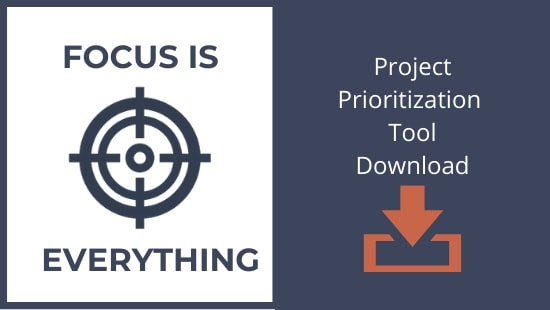Complexity is cost, and too many initiatives drain the organization's resources and hinder its agility. We can't afford this cost if we are going to accelerate post-pandemic recovery and return to growth and profitability during an unprecedented economic environment.
We must simplify.
The winners in this new environment will have the courage and conviction to be decisive and galvanize people into collective action on the “Focus Few” initiatives that support the core business and have the highest ROI opportunities.
Unfortunately, it's not enough to identify the “Focus Few” priority projects. We must commit to aligning the organization and redeploying resources consistent with those priorities.
I've created a Project/Initiative Prioritization Framework and tool you can download to help you analyze projects, identify the Focus Few, pause the worthy but not essential, and kill the projects no longer serving you.
Select the Focus Few
Here's a simple process to help you identify your Focus Few initiatives.
Identify
First, identify all of the strategic and operational projects that are currently underway. You'll want to get input from various team members to make sure you get a complete list. The executive or leadership team is rarely aware of all of the business initiatives in play. So dive deeper to get feedback if you want a comprehensive look at where you've committed resources.
Once you've got this list, organize the initiatives by project type (product development, sales, productivity, run-the-business vs. change-the-business).
Determine Evaluation Criteria
Customize the criteria you decide to use in evaluating your projects to your needs and situation. But if your goal is to return to growth and profitability quicker in a horrible economy, I recommend prioritizing projects that grow sales and profitability with your target (best) customers. Criteria I recommend are:
- Purpose: For me, this should be weighted very heavily. How well does this project serve or business purpose or mission? Is this one of the best ways we can service that purpose/mission?
- ROI: What is the ROI for the project over the evaluation period? I'd keep a shorter timeframe in mind.
- ROI Distribution: How soon will you realize gains on the project? Does the distribution of return occur at the end of the project? ROI is essential, but the timing of the payoff is also a factor. Too many projects that take a while to realize benefits may not be the best choice in this environment.
- Leverage Target Customer Segment: The target customer segment represents the most valuable, most strategic source of income growth. How well does this initiative serve that segment? Prioritize projects that strengthen your position with your target customer base.
- Create Competitive Advantage or Eliminate a Disadvantage: How well does this initiative strengthen your market advantages with the target customer segment? Or how does it eliminate a disadvantage that holds you back?
- Leverage Existing Resource Capacity: Big investments are most likely not an option right now. So how does this project leverage current resources and strengths?
- Ease of Execution: Execution is everything. How easy will it be for the organization to achieve this goal? Have you demonstrated the ability to execute projects similar to this?
- Weighting: Not all the criteria have to be weighted equally in your evaluation, so I've included an option for a weighting factor in the Project Assessment Tool to make it easy for you to customize.
Assess
Please don't asses in a vacuum! Using the evaluation criteria, evaluate each initiative as a cross-functional team. You'll get better insights, particularly regarding “easy of execution” and “leverage existing resource capacity.” The quality of your assessment will depend on the diversity of the perspectives represented.
Once you've evaluated the projects, select the best 3 to 5 initiatives, and now you've got your “Focus Few!”
Deal with the Rest
Categorize the initiatives that didn't make the Focus Few cut into two categories: Push Pause and Kill/Exit.
Push Pause
For the worthy projects that didn't make the initial cut, determine under what conditions you would resume or begin this project. What would have to be true? Defining requirements will provide guidance and clarity and get everyone on your team aligned.
Next, estimate when you expect to see those conditions occurring. While it's only an estimation, it will help your team understand your expectations.
Kill/Exit
For those initiatives you've decided no longer serve the business, you'll want to stop them as quickly as possible and reallocate assets. The timing of the exit may depend on the impact it would have on the business and key customers.
In that case, you'll need a solid exit plan, clear communication, and a champion to lead the process.
Download the Project Prioritization Tool
Sign up for updates and I'll send you my Project Prioritization Guide and Template
Communicate, Rinse and Repeat
Once you've completed this process, share the results with the organization. Sharing this prioritization will go a long way in focusing your teams and aligning the resources needed to get the business back on track.
Set expectations for the timing of future reviews (perhaps quarterly) and changes to the prioritization of initiatives. As projects wrap up, and the organization's capacity and capabilities increase, the list will need to be reviewed and updated to reflect the new priorities.
Focus will be the key to returning to growth and profitability in this post-pandemic recovery period. Channeling the entire organization's energy on the Focus Few initiatives will ensure you gain traction and competitive advantage. You can use this Project/Initiatives Assessment Tool to provide a framework to make the process easier.
The good news is that when we genuinely have the business fully aligned on a few key initiatives, we will achieve our goals. Never underestimate the power of a focused, committed team!
Stay safe and be well.


